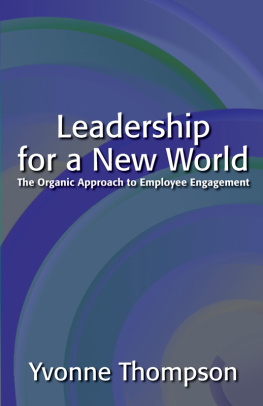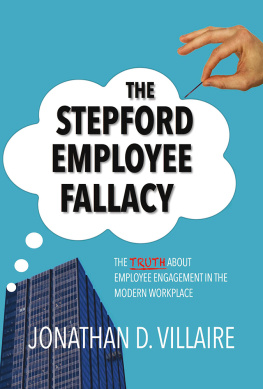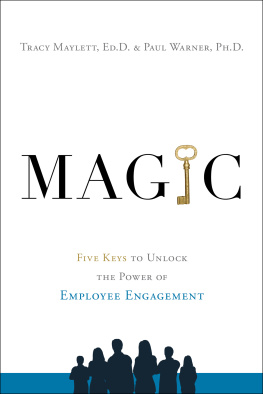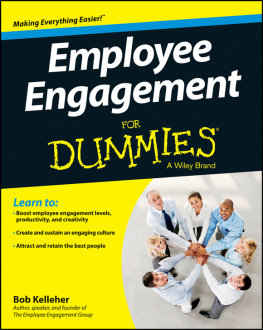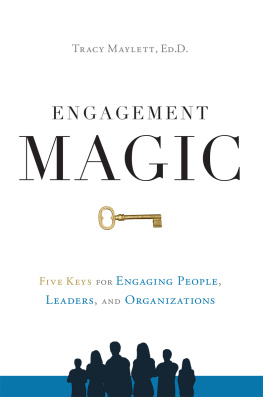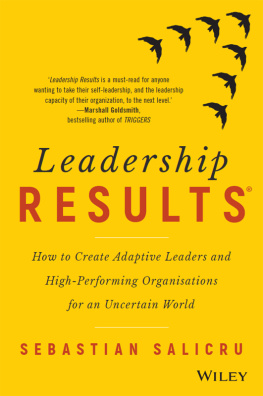

Leadership for a New World:
The Organic Approach to Employee Engagement
copyright Yvonne Thompson 2010
Change Innovators Inc.
1317A Portage Avenue
Winnipeg, Manitoba
R3G 0V3
Canada
www.changeinnovators.com
All rights reserved. No part of this book may be reproduced or transmitted in any form or by any meansgraphic, electronic or mechanicalwithout the prior written permission of the publisher.
Care has been taken to trace the ownership of copyright material used in this book. The author and publisher welcome any information enabling them to rectify any references or credits in subsequent editions.
Excerpts from LET MY PEOPLE GO SURFING by Yvon Chouinard, copyright (c) 2005 by Yvon Chouinard. Used by permission of The Penguin Press, a division of Penguin Group (USA) Inc.
Editor: Amanda Le Rougetel
Printed and bound in Canada by Friesens.
First printing
Library and Archives Canada Cataloguing in Publication
Thompson, Yvonne, 1960
Leadership for a new world : the organic approach to employee engagement / Yvonne Thompson.
Includes bibliographical references.
ISBN 978-0-9865893-0-0
eISBN 9780986589317
1. Leadership. 2. Management. 3. Organizational
effectiveness. 4. Teams in the workplace. I. Title.
HD57.7.T46 2010 658.4'092 C2010-902336-6

This work is dedicated to all of the managers,
supervisors and leaders who are trying to find a holistic
way to meet their employees' needs while increasing
capacity, productivity and employee engagement.
M y philosophy of New World Leadership has evolved organically through a series of events in my life and in collaboration with the team of great people I work with today. As the oldest member of our team (I recently turned 50), I find myself surrounded by members of Generation Y: 20-somethings who have a strong work ethic, clear goals, confirmed passions and significant talent. They bring a lot to their work in my business, Change Innovators Inc.far more than anything I imagined they would when I opened my doors and hired my first employee in 2002.
When I hear business leaders complaining about "the younger generation" and their work ethic, I want to interject and debate with them. Yes, our younger employees have a different set of values than we (Baby Boomers) have, but that makes them just thatdifferent, not wrong. They have clear expectations about work, work hours and work/life balance. At work, they want to contribute in a way that is meaningful to them, whatever that may mean to each individual.
I applaud them for being clear about what they want and what they expect from management. I believe that, in the right environment, younger employees will amaze us with their commitment, loyalty and accomplishments. They want to share, to contribute, to be part of a meaningful enterprise. But that "right environment" doesn't exist automatically. It must be consciously nurtured by leaders who genuinely want to work with their employees and who want to be New World Leaders.
The good news is that, as we head into the 21st century's second decade, I can feel change coming in the business community. I believe that everyone is eager for change in how we do our work and in how we are in business.
As a leadership consultant, I see more and more organizations developing leadership training initiatives, and it gives me hope that we are moving far beyond the limits of management training of the 1970s, 80s and 90s: We do not need any more courses on time management, supervising others, budgeting and negotiations. Numerous such courses already exist, offered by a variety of companies, educational institutions, consultants and trainers. Of course, the technical aspects of being a manager are important, but the true need in today's organizations is for authentic and conscious connections between individuals, within environments that encourage every person to be their very best, every day.
Recently, while teaching a Human Behaviour in Organizations course, I asked a group of managers if they had ever known a manager who was technically not very competent but who was, nonetheless, successful. From the back of the room, Sandra replied: "Yes. I worked for a manager who was an amazing success, one of the best managers in the organization. She was technically not very good but her ability to connect to the team and to create a team of high performers was amazing. We all loved working for her. It was one of the best jobs I ever had." I then asked Sandra how the manager could be successful if she was not technically proficient. It didn't take her long to reply: "We were all very willing to pick up the slack. In fact, we never talked about it. We loved working for her so much. It was just something we all did. It was not a big deal."
Sandra's comments reflect a common theme I hear in my work with clients, students and research participants: Employees are willing to commit themselves beyond the requirements of their job ifwhentheir manager engages them in genuine and meaningful ways.
Difficult People
Two years ago, I received a call from Jennifer, a potential client, who asked me if I would design and deliver a course for her organization on how to deal with difficult people. It took me just a moment to determine my response: "Have you considered why you have difficult people? How many people are you talking about?" Jennifer replied that they had a significant number of employees who were very difficult to deal with and she wanted someone to help the managers in dealing with them. I quietly advised that by looking at the "difficult people", she was looking at a symptomnot the causeof the real problem and she would be wasting everyone's time. She was a little shocked, but didn't hang up. We talked some more.
What I discovered was that the group had been through a significant merger and buy-out. Silos existed throughout the organization; managers did not support each other but instead blamed each other for process problems and manufacturing deficiencies. Managers were telling their teams, "Stick with me and I will protect you." Each team worked in isolation from the others and did not see their impact on the larger unit. Solutions proposed in one area worked for that one area, but any resulting problems were always someone else's fault. It was a culture of blaming and finger pointing. Employees were unhappy and managers were uncooperative with each other. The organization's leaders took a strong command-and-control approach: It's our way or the highway, they implied. Managers were rarely consulted but always expected to execute the leadership's directives.
I'm happy to say that I did not develop and deliver a workshop on how to deal with difficult people. Instead, I worked with Jennifer to determine the real issues, separating out the symptoms and getting down to the root of the problem. Unfortunately, and as it goes with many initiatives, the process did not go as far as we would have liked it to. Fear got in the way: fear of letting go. Senior management was not ready to genuinely engage the managers in changing the organizational culture. It was just too big a leap for them.
New World Leadership
I believe it's time that organizational leaders take a long hard look in the mirror and consider these questions: Why should anyone want to come to work for this organization? What are we all about? What is great about becoming part of our team? These are hard questions that need meaningful answers. "Because we give them a paycheque" is no longer an adequate response! To remain competitive, to attract the best talent, to build effective employee engagement, organizations must change. Survival in the 21st century's business world, which is more holistic than mechanistic, more knowledge driven than task driven, more spiritually fed than ever before, organizations must change how they work. Same old same old is, quite simply, a recipe for failure.
Next page
